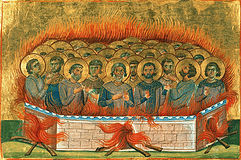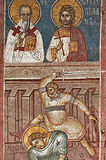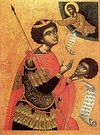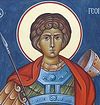

| Previous day | Next day |
| Old Style
November 3
|
Thursday |
New Style
November 16
|
| 24th Week after Pentecost. Tone 6. | No fast.
|
![]() Hieromartyrs Acepsimas, bishop, the priest Joseph, and the deacon Aeithalas, of Persia (376).
Hieromartyrs Acepsimas, bishop, the priest Joseph, and the deacon Aeithalas, of Persia (376). ![]() Dedication of the Church of the Great-martyr George in Lydda (4th c.).
Dedication of the Church of the Great-martyr George in Lydda (4th c.).
Martyrs Atticus, Agapius, Eudoxius, Carterius, Istucarius (Styrax), Pactobius (Tobias), Nictopolion, and companions, at Sebaste (320). St. Acepsimas, hermit, of Cyrrhus in Syria (4th c.). St. Snandulia of Persia (380). St. Anna, daughter of Prince Vsevolod I Yaroslavich (1112).
New Hieromartyrs Nicholas Dinariev, archpriest, of Danevo (Ryazan) (1918); Paul Andreyev and Alexander Zverev, archpriests, of Vozmishche (Moscow), Sergius Kedrov, archpriest, of Faustovo (Moscow), Alexander Parusnikov, archpriest, of Ramenskoye (Moscow), Vladimir Pisarev, archpriest, of Kostino (Moscow), and Vincent Smirnov, archpriest, of Khimki (Moscow) (1937).
St. Achaemonides (or Hormisdas), confessor, of Persia (4th c.). St. Winifred of Holywell, Wales (630). St. Hubert, bishop of Liege (727). St. Pirmin, bishop and monastic founder (Germany) (753). St. Theodore, confessor, bishop of Ancyra (8th-9th c.). The Meeting [1196] of St. Sava [1235] and St. Symeon the Myrrh-gusher [1200], of Serbia, at Vatopedi [Mt. Athos]. St. Nicholas of Iveron (Mt. Athos) and Georgia, hymnographer (1308). St. Pimen, monk of Zographou (Mt. Athos) (1610). New Hieromartyr George, priest, of Neopolis, Asia Minor (1797).
Thoughts for Each Day of the Year
According to the Daily Church Readings from the Word of God
By St. Theophan the Recluse

Thursday. [I Thess. 5:1-8; Luke 11:47-12:1]
Beware ye of the leaven of the Pharisees, which is hypocrisy. The distinguishing feature of hypocrisy is to do everything for show. To do things where others can see is not yet hypocrisy because a large portion of our required deeds must be done for people, and consequently amidst them and in their view. And although those who manage to do everything secretly do better, it is not always possible; this is why one cannot immediately blame those who act in sight of others with desire for ostentation or show. They might have a sincere desire to do good, while showing others is a necessary accompaniment for deeds done outwardly. Hypocrisy begins the moment there appears the intention not to do good, but only to show yourself as doing good. And this again is not always an offence, because there can be a momentary attack of evil thoughts which are immediately noticed and chased away. But when one has it in mind to make a reputation for himself as a benefactor, there is already hypocrisy, which enters deeply into the heart. When a hidden goal of taking advantage of the benefits of such a reputation is added to this, then hypocrisy is in full vigour. Everyone, look at what the Lord requires when He commands to beware of the leaven of the Pharisees. Do good according to a desire to do good to others, according to the consciousness that God’s will is for this, unto the glory of God. But do not worry about people looking at it—and you will avoid hypocrisy.
Articles
 Martyr Aithalas of PersiaThe Holy Martyr Aithalas the Deacon, by order of the Persian emperor Sapor II, was put to death by stoning in the year 380 for confessing Christ. |
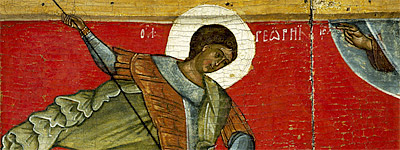 Great Martyr George |
 Venerable Akepsimas the Hermit of Cyrrhus in SyriaSaint Akepsimas, Hermit of Cyrrhus in Syria lived for sixty years in the desert, not far from Cairo. |
 Saint Snandulia of PersiaSnandulia was a devout Christian of the city of Arbela who visited those who suffered in prison for the sake of Christ. |
